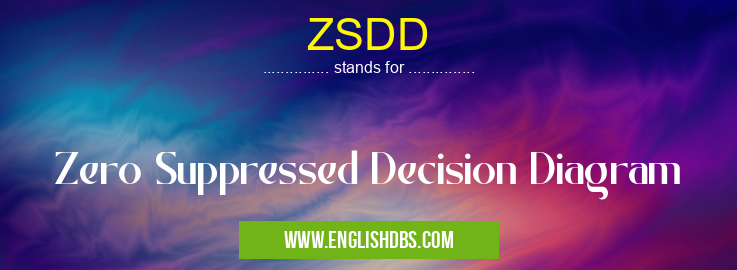What does ZSDD mean in UNCLASSIFIED
ZSDDs are constructed by starting with a root node that represents the top-level variable of the Boolean function. Each node in the ZSDD has two child nodes, one for the case when the variable is 0 and one for the case when the variable is 1. The child nodes are then recursively constructed in the same way, until all of the variables in the function have been represented.

ZSDD meaning in Unclassified in Miscellaneous
ZSDD mostly used in an acronym Unclassified in Category Miscellaneous that means Zero Suppressed Decision Diagram
Shorthand: ZSDD,
Full Form: Zero Suppressed Decision Diagram
For more information of "Zero Suppressed Decision Diagram", see the section below.
How ZSDDs Work
Advantages of ZSDDs
- ZSDDs are more compact than BDDs, which makes them more efficient to store and process.
- ZSDDs can be used to represent functions that cannot be represented by BDDs.
- ZSDDs are easy to manipulate and update, which makes them well-suited for use in applications such as logic synthesis and formal verification.
Essential Questions and Answers on Zero Suppressed Decision Diagram in "MISCELLANEOUS»UNFILED"
What is a Zero Suppressed Decision Diagram (ZSDD)?
A Zero Suppressed Decision Diagram (ZSDD) is a data structure used to represent Boolean functions. It is a compact and efficient way to represent functions with a large number of variables. ZSDDs are often used in computer-aided design (CAD) and other applications where Boolean functions are used to describe complex systems.
How does a ZSDD work?
A ZSDD is a directed acyclic graph (DAG) where each node represents a variable in the Boolean function. The edges of the graph are labeled with 0 or 1, and they represent the values of the variables that lead to the next node. The leaves of the graph are labeled with either 0 or 1, and they represent the output of the function.
What are the advantages of using a ZSDD?
ZSDDs have several advantages over other data structures for representing Boolean functions. They are compact, easy to construct, and can be evaluated quickly. ZSDDs are also canonical, meaning that there is only one ZSDD for a given Boolean function.
What are the disadvantages of using a ZSDD?
ZSDDs can be difficult to understand and manipulate. They can also be large for functions with a large number of variables.
When should I use a ZSDD?
ZSDDs are most useful for representing Boolean functions that are large and complex. They are often used in CAD and other applications where it is important to represent Boolean functions compactly and efficiently.
Final Words: ZSDDs are a powerful data structure that can be used to represent Boolean functions in a compact and efficient way. They have a number of advantages over BDDs, including their ability to represent functions that cannot be represented by BDDs. ZSDDs are used in a variety of applications, including logic synthesis and formal verification.
